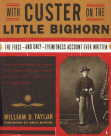
With Custer on the Little Bighorn is a book from the manuscript of U.S. Seventh Cavalry veteran William O. Taylor. It is the first-and only-eyewitness account of that 1876 battle ever written.
This book is now available in both hard and paperback versions published by Viking Penguin; forwarded by editor Greg Martin, who is an author, artifacts collector, and consultant to the auction house Butterfield & Butterfield. Martin discovered Taylor's manuscript in 1994 in a collection Custer and "Indian" War related artifacts. Included in that collection was an unpretentious old black tin box with William O. Taylor's personal papers and his manuscript, intended to be a book which never got published before he died in 1923.
Taylor was born in Canandaigua, NY in 1855, and on January 17, 1872, seeking adventure, he joined the U.S. Army in Troy, NY. About a month later he found the adventure that he was seeking when he was assigned to Troop M of the Seventh United States Cavalry Regiment.
After participating in all of Lieutenant Colonel (formerly General) George A. Custer's expeditions through the Yellowstone in 1873 and the Black Hills in 1874, Private Taylor joined Troop A, under Captain Myles Moylan, in 1876. The rest of the story is ingrained in history as the regiment left Fort Abraham Lincoln, Dakota Territory, to confront the Sioux and Northern Cheyenne. On the morning of June 25, contact was made.
Only barely spared the fate of the rest of the regiment because Troops A, M, and G were assigned to Major Reno's division from the main body, Private Taylor lived to tell about it. Taylor's firsthand account is starkly vivid combat. The publishing of his manuscript is so recent that it is of course not even included as bibliography in Evan S. Connell's epic: Son of the Morning Star.
Taylor's book is a MUST for, at least, all U.S. Seventh Cavalry veterans because of his description of the march to the Little Bighorn engagement, and it should be of historical significance to all who are interested in that story. I personally know what it was like to be on the move in the Seventh Cav to engage an enemy, and now I know from a veteran of that regiment what it was like on that famous 1876 campaign.
Taylor became like a lot of G.I.'s do, transcending the dehumanizing hate rhetoric of the administration that sent him, to try to understand the enemy that he fought against. In his own words he says: "'Rounding up the hostile,' or in other words seeking to deprive a strange and brave people of their birthright and all they held dear, was not altogether a picnic."
Was that genocide, or American ethnic cleansing? All is in the eye of the beholder; and the only alliance to police the United States, was defeated.
Taylor includes the period poem: "The Only Good 'Indian'." I for one, though, do not succumb to the Christopher Columbus faux pas and I refuse to call them "Indians." "They" as well, are not from India, nor in any way resemble Indians.
The hardships of that campaign effected Taylor's, like so many other troopers with him, health and he was discharged from the Army on January 17, 1877. He retired to Orange, MA, where he researched and compiled his manuscript for this book, bequeathing the black tin box to his wife, who in 1958, shortly before her death, passed it along in her family to be published.
The manuscript ended up being sold to a New York art dealer where it found its way to Butterfield & Butterfield. One book reviewer put it mildly when they said, "No one who values American history should overlook Taylor's contribution."
FIRST TEAM! Garryowen, Mike Bodnar C 2\7 Cav 1969




